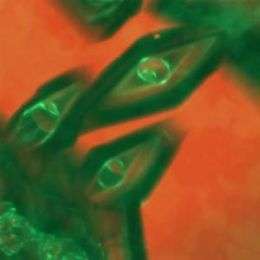Fluorescence microscopy reveals why some antifreeze proteins inhibit ice growth better than others

Antifreeze or “ice structuring” proteins – found in some fish, insects, plants, fungi and bacteria – attach to the surface of ice crystals to inhibit their growth and keep the host organism from freezing to death. Scientists have been puzzled, however, about why some ice structuring proteins, such as those found in the spruce budworm, are more active than others.
Fluorescence microscopy now has shown how those aggressive proteins protect the cells of the insect, which is native to U.S. and Canadian forests.
The finding could have future applications in medical, agricultural and commercial food industries, according to a team of scientists led by Ido Braslavsky, an assistant professor of physics and astronomy at Ohio University, and Peter Davies, a professor of biochemistry and biology at Queen’s University in Canada. They presented the work today at the March meeting of the American Physical Society in Denver, Colo.
In the recent study, Davies’ lab combined spruce budworm and fish antifreeze proteins with a fluorescent tag. Using a fluorescent microscope, Braslavsky and postdoctoral fellow Natalya Pertaya could observe how the proteins interacted with the surfaces of ice crystals. They found that the hyperactive antifreeze protein from the spruce budworm stops ice crystals from growing in particular directions. The antifreeze proteins from fish are less effective.
Antifreeze proteins, especially the hyperactive type found in the spruce budworm and other organisms, have various potential applications, according to Braslavsky. They could be used to preserve organs and tissues for medical applications such as transplants, and also could prevent frostbite. They also can inhibit crystal growth in ice cream – an application already in use by at least one commercial food manufacturer – as well as protect against agricultural frost damage.
Source: Ohio University





















